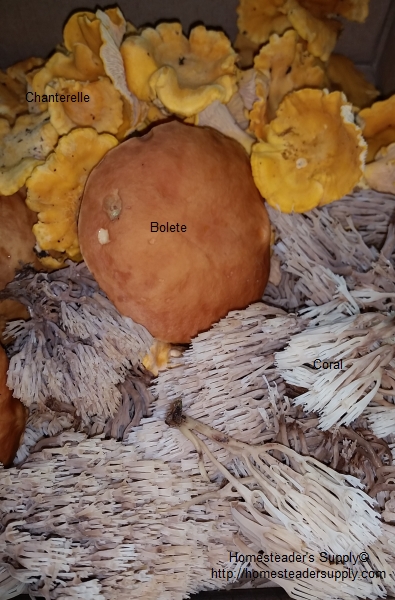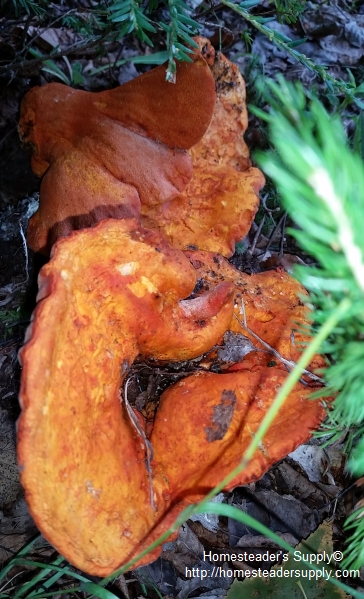Tips for Hunting Wild Mushrooms
Picking mushrooms has been an important part of stocking the homesteader’s pantry for many generations. Lessons are passed down from generation to generation, shared with friends, written in books and presented in workshops. These tips will help you get started as a mushroom hunter and improve your skills and methods.

Chanterelle, Bolete, Coral mushrooms
- Take a class or workshop before you pick your first wild mushroom. Better safe than sorry. One mistaken amanita could end your mushroom hunting days…permanently. The workshop or class should include a hands-on mushroom walk with an experienced guide. Or, go with a friend who is well versed in mushrooms and doesn’t hesitate to say “I don’t know what it is.” Look for workshops and classes through land trusts, cooperative extensions or organic co-ops.
- Invest in guide books. They are no replacement for a knowledgeable person but they do have a solid place in mushroom hunting. Read the books as needed, study the photos, look up answers to your questions. Write down questions that pop up as you’re reading. Look for guides with color photography.
- Have the tools you need. You don’t need much.
- A knife. You’ll cut off the dirt-covered end of the stem to keep the rest of the mushroom lean. A sharp pocket knife is plenty. Dirty mushrooms can be hard to get clean so keep them as clean as possible.
- Newspaper. A layer of newspaper between layers of mushrooms will absorb moisture and block dirt from falling to the mushrooms below.
- A basket or other container to hold the mushrooms you’ve picked. It should be wide but not too deep. You don’t want to stack delicate mushrooms so high they get crushed. Recycled bread trays are great. They have plenty of room between trays for larger mushrooms and will stack as high as you have room to stack them. Line the bottom of each tray with newspaper.
- Your guide books. This is when ebooks are handy. One Kindle weighs a lot less than three or four books and take up less room.
- A camera is handy when you’re unsure of a mushroom you aren’t going to pick. Take pictures of the mushroom from different angles and of the surrounding. Knowing what kinds of trees are growing nearby, the amount or lack of sunlight and proximity to water can be helpful.
- Paper and pen, in case you want to make notes or jot down questions.
- Start out in familiar territory and ask permission where necessary. Nobody need get lost over a mushroom. Stay on the trails when possible. Many of us hunt from the road and look into the woods and up and down banks. If you’re tagging along with an experienced hunter before courteous and respectful of that person’s favorite places, and don’t go back unless invited. It can take years to find a good spot.
- Leave some of the mushrooms in every patch you find. They don’t all grow in groups so there are exceptions. If you find a few leave one to spread its spores. If a mushroom is past its prime (“going by” or “gone by”) you should leave it untouched.
- Look around. Where are the mushrooms you find growing? Some varieties are very particular. They might grow only at the base of an oak tree or dying hardwoods, for example. Make notes:
- “Chanterelles. At a hemlock near the stream.”
- “Corals. On a decaying log on the road to Ben’s camp.”
- “Unknown. Photo taken. Red top, white flesh and stem. Gills on top, solid stem.”
- Back at home, use your resources to make sure your mushrooms are safe if you have any doubt. If you’re still not sure you should pass on eating it this time.
- Clean the mushrooms by wiping them with a dry or slightly damp towel. Don’t get them wet.
- Try one new variety of mushroom at a time. If you have a reaction you need to know what mushroom didn’t agree with you. One or two bites of one cooked mushroom is a good start. Wait a few days between new varieties.
- A little salt and maybe some pepper are all you need for that first bite. You want to know if you like the taste of the mushroom. From there you can decide what you want to add when cooking.

Coral Mushroom
Chanterelles are a popular mushroom that most people seem to favor. The going price in northeastern Maine right now is $28 per pound, and around $50 per pound in New York City according to friends who wild harvest and sell to chefs. Knowing that makes them that much better! This recipe is hard to beat.
Cooking Chanterelles
1 pound of Chanterelles, cleaned and sliced into 1/4″ thick slices
1/4 cup bacon fat
4 tablespoons butter
1 small, mild onion, diced
Saute mushrooms and onions in the fat and butter until the onions are translucent.

Lobster Mushrooms
If you pick more mushrooms than you can use fresh you can put them up for later. Personal preference plays a large part in your preserving method. Some folks prefer to saute mushrooms in olive oil and then freeze them. Others can their mushrooms and some dehydrate their extras.
